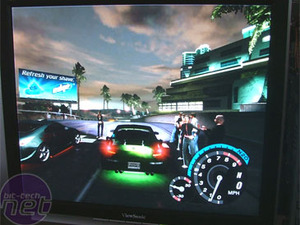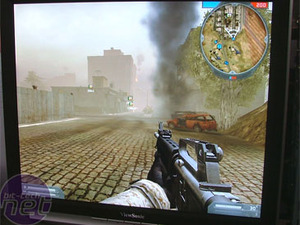
Controls
The OSD is fairly simple and effective. There are controls, as you'd expect, for colour, brightness, contrast - although the selection buttons are labelled, rather confusingly, as '1' and '2' rather than 'Menu' and 'Select'. There are also various colour profiles and a memory setting - enough tweakery for most.

Brightness and contrast
If there is one test of a gaming monitor's capabilities when it comes to picture, it's Doom 3. Sporting more shades of black than any other game known to man, it has been known to bring many TFTs to their knees - indeed, I specifically went out and bought a CRT monitor to play Doom 3 on, such was the incapability of my TFT at the time.
In terms of viewing angle, we found that you could look almost sideways on at the monitor without a skewing of colours. Obviously, if you intend to be watching movies on this screen (and with 4ms response and great black rendering, why not?) this is a good thing.
Response time
Of course, the big seller for this monitor is the 4ms response time. A couple of years ago, 25ms was the norm for TFTs, and the ghosting on these displays while gaming was evident. Hitachi broke the mould with their first 16ms screen, and since then, 12 and 8ms displays have become prevalent.ViewSonic call their 4ms technology ClearMotiv. How does it work? Well, simply, the monitor pre-charges the pixels in the screen with voltage (either higher or lower, depending on whether the next colour is brighter or darker). By pre-charging, it can make the actual switch between pixel colours faster. There's some good, detailed explanation of the 4ms technology here, if you want some hardcore tech.
However, can the human eye really see much difference at these low latency levels?
To put the monitor to the test, we fired up a couple of fast-paced games - namely, Battlefield 2 and Need For Speed: Underground 2 - and set the ViewSonic down next to a 16ms Hitachi display. Then we played.


On the image quality side, we found NFSU2 almost unplayable on the Hitachi because of its incapabilities with blacks. The screen, in some night scenes, became just a wash of mud - with the Viewsonic, the game was a pleasure to play.
Testing next to a 8ms Viewsonic (the same monitor with a slower response, effectively), we were able to discern no real difference in the speed. Both were fantastically fast, and entirely sufficient for gaming. Whilst CRT purists would argue that LCDs still can't match tube technology for gaming, I'd challenge anyone to sit and actually play something on this LCD and complain about ghosting or picture quality. Quibble over tech specs and DisplayMate results all you want - you won't see the difference in the real world.
Pricing and value
The VX924 is available now for £300. That compares to £250 for the 8ms version and £175 for a no-name 19" monitor. What can we say? Well, investing in the 8ms ViewSonic (identical to this model in all but the response time) is, we would say, a no-brainer. The greater contrast ratio and panel quality over a no-name brand means that gamers are going to be far happier with their purchase, and games will be a heck of a lot more enjoyable when you can see what you're doing. The picture quality on these monitors really is outstanding, especially when you think about the resolution scaling.Is the price differential between the 8ms and the 4ms worthwhile? Well, we'd suggest possibly not. The VX924 is a cracking monitor, we're just not really sure that any gamer, unless they have robotic eyes, is going to see the difference between 4ms and 8ms response.
The 19" is either a love it or hate it size - some will love the extra screen size for gaming, others will hate what they perceive to be Windows bloat. However, this is designed to be a gaming monitor, and we think that the size is a bonus on this front.
So, our first monitor review. The verdict? A great panel, but save yourself the cash and get the 8ms version - all the picture quality, all the Doom 3 goodness, a little less price.
Now if only ViewSonic made flashlight-enabled rifles...

MSI MPG Velox 100R Chassis Review
October 14 2021 | 15:04





Want to comment? Please log in.